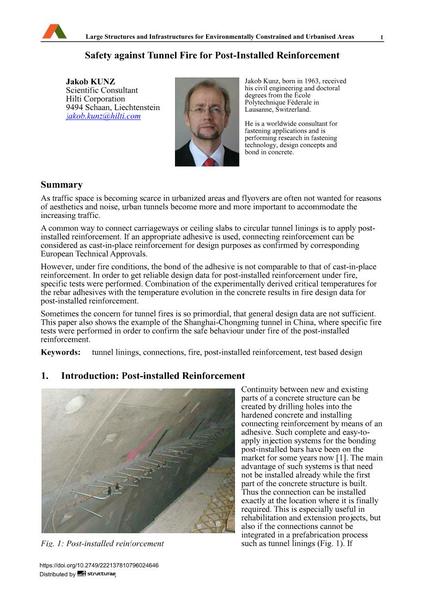Safety against Tunnel Fire for Post-Installed Reinforcement

|
|
|||||||||||
Bibliografische Angaben
| Autor(en): |
Jakob Kunz
|
||||
|---|---|---|---|---|---|
| Medium: | Tagungsbeitrag | ||||
| Sprache(n): | Englisch | ||||
| Tagung: | IABSE Symposium: Large Structures and Infrastructures for Environmentally Constrained and Urbanised Areas, Venice, Italy, 22-24 September 2010 | ||||
| Veröffentlicht in: | IABSE Symposium Venice 2010 | ||||
|
|||||
| Seite(n): | 304-305 | ||||
| Anzahl der Seiten (im PDF): | 7 | ||||
| Jahr: | 2010 | ||||
| DOI: | 10.2749/222137810796024646 | ||||
| Abstrakt: |
As traffic space is becoming scarce in urbanized areas and flyovers are often not wanted for reasons of aesthetics and noise, urban tunnels become more and more important to accommodate the increasing traffic. A common way to connect carriageways or ceiling slabs to circular tunnel linings is to apply post- installed reinforcement. If an appropriate adhesive is used, connecting reinforcement can be considered as cast-in-place reinforcement for design purposes as confirmed by corresponding European Technical Approvals. However, under fire conditions, the bond of the adhesive is not comparable to that of cast-in-place reinforcement. In order to get reliable design data for post-installed reinforcement under fire, specific tests were performed. Combination of the experimentally derived critical temperatures for the rebar adhesives with the temperature evolution in the concrete results in fire design data for post-installed reinforcement. Sometimes the concern for tunnel fires is so primordial, that general design data are not sufficient. This paper also shows the example of the Shanghai-Chongming tunnel in China, where specific fire tests were performed in order to confirm the safe behaviour under fire of the post-installed reinforcement. |
||||
| Stichwörter: |
Brand
|
||||
